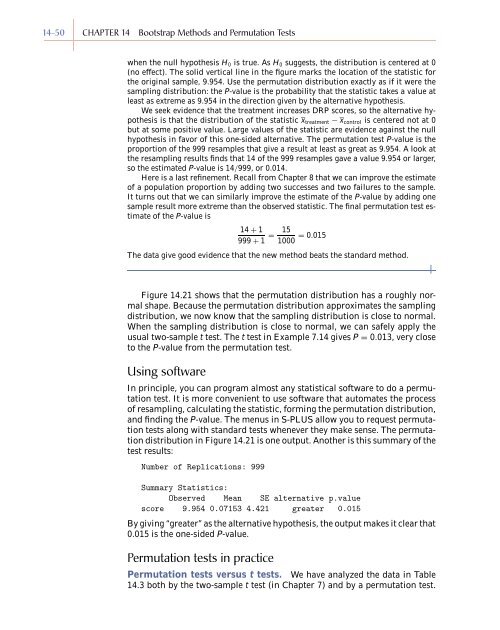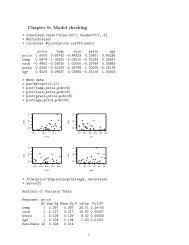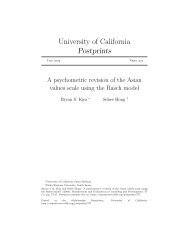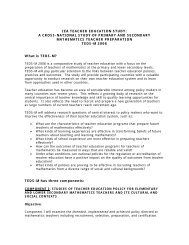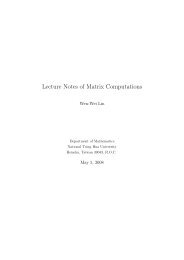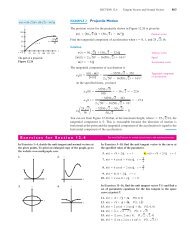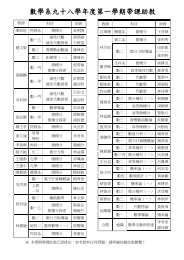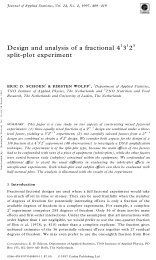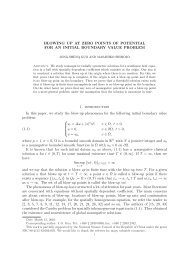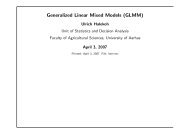Chapter 14 - Bootstrap Methods and Permutation Tests - WH Freeman
Chapter 14 - Bootstrap Methods and Permutation Tests - WH Freeman
Chapter 14 - Bootstrap Methods and Permutation Tests - WH Freeman
Create successful ePaper yourself
Turn your PDF publications into a flip-book with our unique Google optimized e-Paper software.
<strong>14</strong>-50 CHAPTER <strong>14</strong> <strong>Bootstrap</strong> <strong>Methods</strong> <strong>and</strong> <strong>Permutation</strong> <strong>Tests</strong><br />
when the null hypothesis H 0 is true. As H 0 suggests, the distribution is centered at 0<br />
(no effect). The solid vertical line in the figure marks the location of the statistic for<br />
the original sample, 9.954. Use the permutation distribution exactly as if it were the<br />
sampling distribution: the P-value is the probability that the statistic takes a value at<br />
least as extreme as 9.954 in the direction given by the alternative hypothesis.<br />
We seek evidence that the treatment increases DRP scores, so the alternative hypothesis<br />
is that the distribution of the statistic x treatment − x control is centered not at 0<br />
but at some positive value. Large values of the statistic are evidence against the null<br />
hypothesis in favor of this one-sided alternative. The permutation test P-value is the<br />
proportion of the 999 resamples that give a result at least as great as 9.954. A look at<br />
the resampling results finds that <strong>14</strong> of the 999 resamples gave a value 9.954 or larger,<br />
so the estimated P-value is <strong>14</strong>/999, or 0.0<strong>14</strong>.<br />
Here is a last refinement. Recall from <strong>Chapter</strong> 8 that we can improve the estimate<br />
of a population proportion by adding two successes <strong>and</strong> two failures to the sample.<br />
It turns out that we can similarly improve the estimate of the P-value by adding one<br />
sample result more extreme than the observed statistic. The final permutation test estimate<br />
of the P-value is<br />
<strong>14</strong> + 1<br />
999 + 1 = 15<br />
1000 = 0.015<br />
The data give good evidence that the new method beats the st<strong>and</strong>ard method.<br />
Figure <strong>14</strong>.21 shows that the permutation distribution has a roughly normal<br />
shape. Because the permutation distribution approximates the sampling<br />
distribution, we now know that the sampling distribution is close to normal.<br />
When the sampling distribution is close to normal, we can safely apply the<br />
usual two-sample t test. The t test in Example 7.<strong>14</strong> gives P = 0.013, very close<br />
to the P-value from the permutation test.<br />
Using software<br />
In principle, you can program almost any statistical software to do a permutation<br />
test. It is more convenient to use software that automates the process<br />
of resampling, calculating the statistic, forming the permutation distribution,<br />
<strong>and</strong> finding the P-value. The menus in S-PLUS allow you to request permutation<br />
tests along with st<strong>and</strong>ard tests whenever they make sense. The permutation<br />
distribution in Figure <strong>14</strong>.21 is one output. Another is this summary of the<br />
test results:<br />
Number of Replications: 999<br />
Summary Statistics:<br />
Observed Mean SE alternative p.value<br />
score 9.954 0.07153 4.421 greater 0.015<br />
By giving “greater” as the alternative hypothesis, the output makes it clear that<br />
0.015 is the one-sided P-value.<br />
<strong>Permutation</strong> tests in practice<br />
<strong>Permutation</strong> tests versus t tests. We have analyzed the data in Table<br />
<strong>14</strong>.3 both by the two-sample t test (in <strong>Chapter</strong> 7) <strong>and</strong> by a permutation test.


